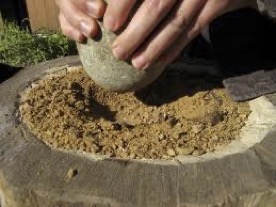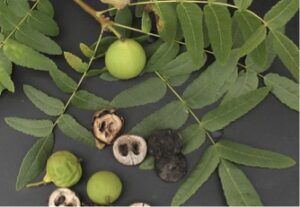How Can We Help?
What can I eat in the wild?
No matter where you are in the world – except Antarctica – someone has lived there before you -- probably for thousands of years. Wherever you live, wherever you move in the future, it makes sense to head for the library, or get on the internet, and find out how people lived there, long ago.
Around here, the first locals were Native Americans of the Chumash tribe. Some of the foods in this guide are ancient parts of the Chumash diet; others were brought by the Spanish but soon became part of the Chumash diet and the local ecosystem.
Of course ancient people everywhere hunted wild animals, and fished. You will learn those skills from later courses, or directly from your own Dads. But tonight we’re going to talk about edible plants. Not quite as interesting or as much fun to catch – but certainly easier.
In any given environment there are probably hundreds of plants that are “edible” in the sense that you could eat them without dying or getting sick. But many of them are either not nutritious enough, or too rare, to be worth the effort of looking for them. Only a true specialist can take the time to learn thousands of plants but anyone can learn a dozen or so of the most common and easiest to recognize.
I have made every effort to avoid using images for which copyright is claimed. However since things get reposted around the net, I might have unintentionally used something proprietary. If you believe I shouldn’t be using some of these images, please let me know at once. In any case, I derive neither profit nor political gain from their use. PB
Prickly Pear Cactus – Opuntia (several species)
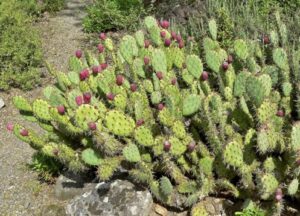
The young tender pads are a nutritous vegetable, called “nopalitos” in Mexican cuisine. Scrape off the spines before eating! Even the domesticated “spineless” type has some small spines.
The fruits are called “prickly pears”or “cactus pears” in English, “tunas” in Spanish. Knock fruit off the plant, then sweep them back and forth on the ground many times with a leafy branch. The spines will go into the leaves, and then you can handle the fruit. Skin, eat, and spit out the seeds where new cactus might grow.
The whole plant is a storehouse of the most important nutrient of all – WATER. Even the old, fibrous pads, which are too tough to eat, can be mashed up between rocks, and the water can be sopped up into a towel or t-shirt and then squeegied into your mouth!
Oaks – Quercus (coast live oak above, valley oak below)
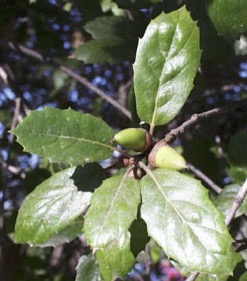
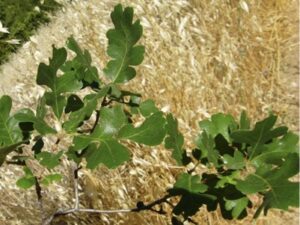
Oak seeds – acorns – mostly are too bitter to eat when raw. Chumash, other California natives, and also some ancient Mediterranean cultures, would dry them out, remove them from their shells, grind them into flour, and then soak in several changes of water to leach out the bitterness. Soaking can be done in a pot, a sand basin, or in a shirt or other piece of cloth used as a filter. It produces food but it’s very laborious; the Chumash reportedly gladly switched to beef as soon as the Spanish introduced longhorns.
If you’re short of water, acorns are not a good idea. The process uses a lot of water. Unless you can distill the water and re-use it (that’s another class, another day.)
Grinding acorns, the hard way….
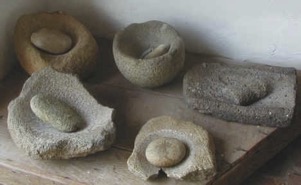
Almost ready to soak…
Southern California black walnut (Juglans calfornica)
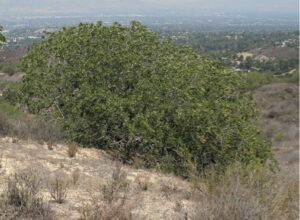
Related to the domestic walnut and sometimes used as a grafting rootstock for it. So-Cal black walnuts are tasty, but too hard for a nutcracker. You’ll need a hammer or a sturdy rock. Also, the green hulls will stain your hands dark brown – be careful, it lasts for weeks.
Holly leaf cherry (Prunus ilicifolia)
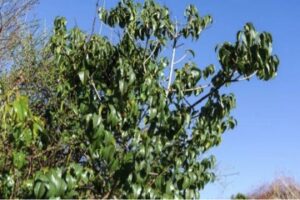
The seed is larger, and the fruit coating is thinner than domestic cherries, but they are very definitely edible. You’ll see the pits in coyote scat, as they eat cherries.
The hard pits can be cracked open to reveal a seed that looks like a small almond but – like regular cherry pits – is POISONOUS. Chumash and other tribes used to grind and leach away the bitter poison in the same way that they did with acorns – however, the cherry pits are much more dangerous if you make a mistake. I’d suggest avoiding it. Just eat the fruit.
Elderberry (Sambucus mexicana)
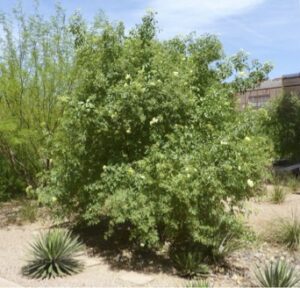
Eat the berries. Or dry them like raisins and eat them later. These grow all over the west, but people don’t notice them. Some people don’t react well to raw elderberries (upset stomach); however, everyone (unless allergic) can eat them cooked.
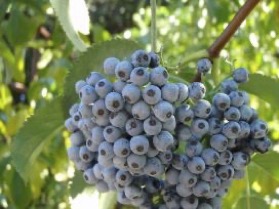
Toyon berry (Heteromeles arbutifolia)
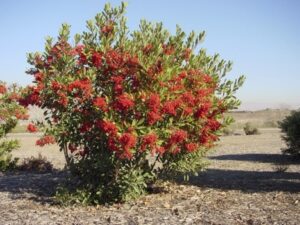
Chumash preferred the berries cooked. Generally available in winter. Note the tooth-edged leaves. Not the best tasting, but food is food.
Cattails (Typha species)
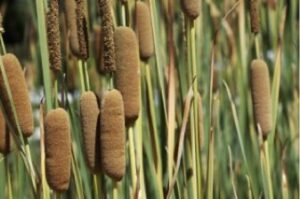 Young shoots can be cooked and eaten (if too old they are too tough); the pollen heads, when blooming can be shaken and used as flour, and the roots are starch and can be used like potatoes.
Young shoots can be cooked and eaten (if too old they are too tough); the pollen heads, when blooming can be shaken and used as flour, and the roots are starch and can be used like potatoes.
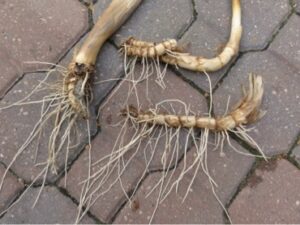
Wild grape (Vitis girdiana, and farther north, Vitis californica)
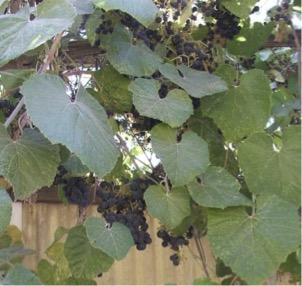 Usually found in streambeds. Just eat the fruit. Can crossbreed with European wine-grapes (see the wild-bred redleaf hybrid below)
Usually found in streambeds. Just eat the fruit. Can crossbreed with European wine-grapes (see the wild-bred redleaf hybrid below)
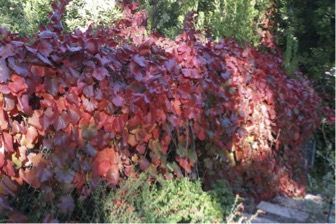
Chia (Salvia columbariae) and related Salvia (sage) species
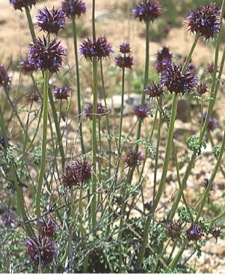 Small, nutrient rich seeds. Chumash would beat the dry chia seed heads with a stick and knock them into a basket. Dry sunflower seedheads can be harvested the same way:
Small, nutrient rich seeds. Chumash would beat the dry chia seed heads with a stick and knock them into a basket. Dry sunflower seedheads can be harvested the same way:
Wild sunflower (Helianthus annus)

Wild black mustard (Brassica nigra) and related species
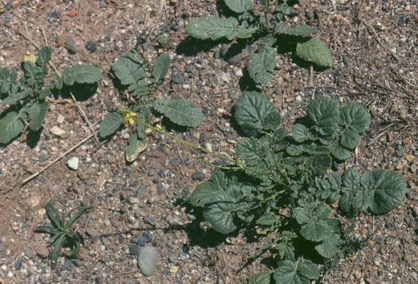 A Spanish import that went wild. Greens and the small yellow flowers can be eaten. Seeds can be crushed into mustard. Turns entire hillsides yellow.
A Spanish import that went wild. Greens and the small yellow flowers can be eaten. Seeds can be crushed into mustard. Turns entire hillsides yellow.
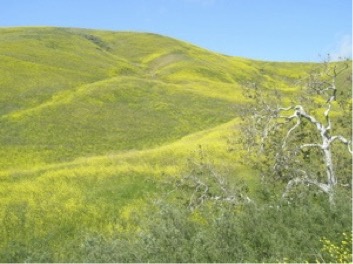
Wild fennel (Foeniculum vulgare)
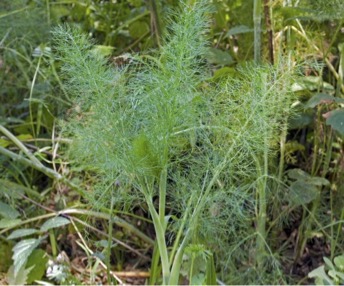
Another Spanish import gone wild. Beloved in Italian and Greek cuisine. Licorice like flavor.
BEWARE of lookalikes (1) a similar plant with white flowers and spotted stalks is poisonous hemlock. (2) a similar plant with yellow flowers but nonlacey leaves, is wild parsnip which causes rashes.
If it does NOT smell licorice-like, it’s not fennel.
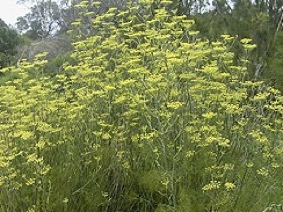
Miner’s lettuce (Claytonia perfoliata)
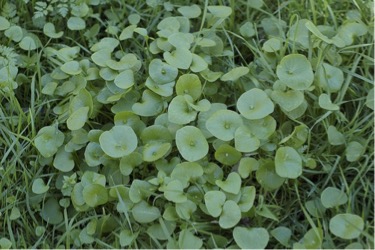
Tasty fresh greens, for free. Not hot or spicy like mustard.
Wild Oat (Avena fatua, Avena barbata)
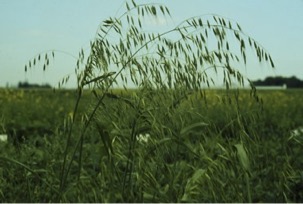
Most of California’s native grasses, once food for the Chumash, have been largely replaced by this Mediterranean invader. The seeds can be dried, cracked, separated from the hulls by fanning or “winnowing”, and then cooking. Laborious, but it’s oatmeal…
Pines (many Pinus species; the below is Pinus monophylla, the single leafed pinyon found in Los Padres National Forest)

Pine needles are rich in vitamin C and can be eaten raw or used to make tea. All pine seeds are edible in theory but only a few species have seeds large enough to be worth the effort; these are called “nut pines.” If in doubt, roast open a mature cone to check the seed size.
In the mountains around us, there are native nut pines -- Gray Pine, Coulter Pines, and Pinyon Pines. In the valleys and near the coast, the introduced Italian Stone Pine can be found.
On Santa Cruz Island there is a stand of Torrey Pines, but they are too endangered to harvest!

Feral Fig (Ficus carica)
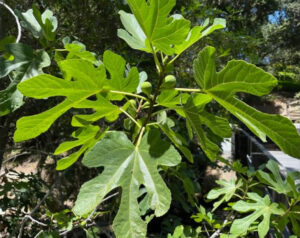
Another escaped Mediterranean import, figs have gone wild in many California streambeds and occasionally elsewhere. Their spread is limited by the fact that their roots are very tasty to the western pocket gopher, which can completely de-root and kill young fig trees.
Even so, they are widespread enough in California to inspire a whole new sport of wild fig hunting; the tastiest trees are propagated from cuttings to become new cultivars.
Figs are not “fruits”, they are inverted flowers. Freely breeding wild fig populations contain “male” (technically hermaphrodite) and female trees, the proportions of which depend on the genetics of the local founding stock. Only the female trees produce edible figs. The others produce flowers that look just like edible figs externally but are full of pollen and pollinator wasps and aren’t appetizing to us (although goats like them, hence their old name, “caprifigs”.)
Fig sap contains a protein-degrading enzyme, which can be irritating to human skin. The sap of some tropical fig species is used to treat parasites and skin cancers, and there is ongoing research on domestic fig sap for the same purposes. Still, it’s better to go to a doctor until/unless such therapies are validated.
The above wild-fig photo was taken in a streambed in Calabasas.
Put together by our Adventurer Advisor, this great article will give you information on what plants you can safely eat in the Southern California area. (also available for download in PDF form here)
